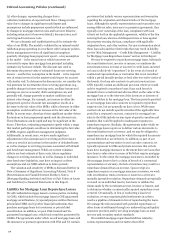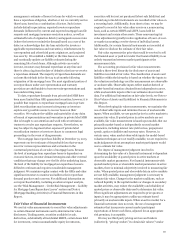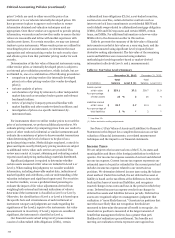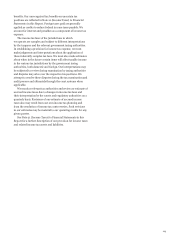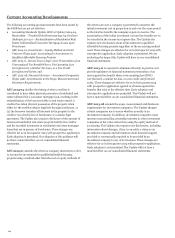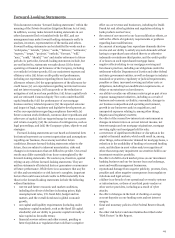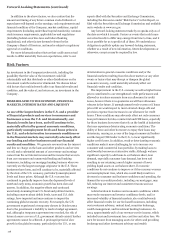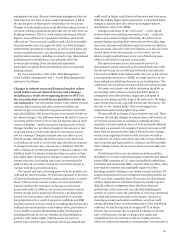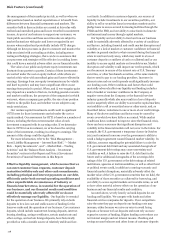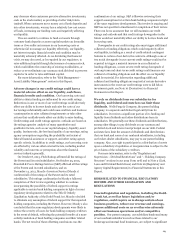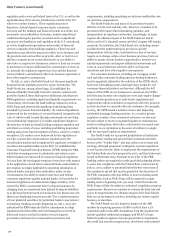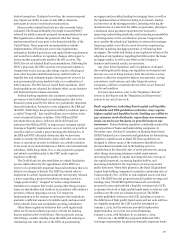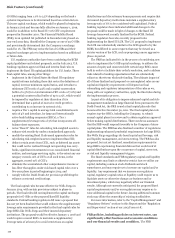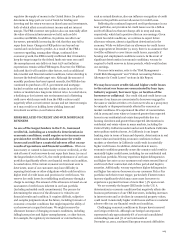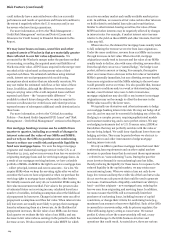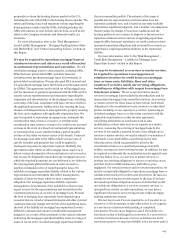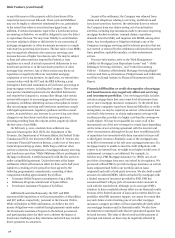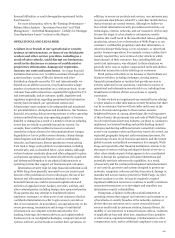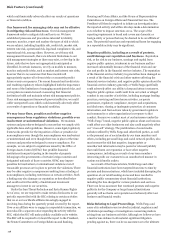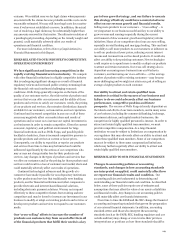Wells Fargo 2013 Annual Report Download - page 122
Download and view the complete annual report
Please find page 122 of the 2013 Wells Fargo annual report below. You can navigate through the pages in the report by either clicking on the pages listed below, or by using the keyword search tool below to find specific information within the annual report.Risk Factors (continued)
regulation under state and federal laws in the U.S., as well as the
applicable laws of the various jurisdictions outside of the U.S.
where we conduct business. These regulations protect
depositors, federal deposit insurance funds, consumers,
investors and the banking and financial system as a whole, not
necessarily our stockholders. Economic, market and political
conditions during the past few years have led to a significant
amount of new legislation and regulation in the U.S. and abroad,
as well as heightened expectations and scrutiny of financial
services companies from banking regulators. These laws and
regulations may affect the manner in which we do business and
the products and services that we provide, affect or restrict our
ability to compete in our current businesses or our ability to
enter into or acquire new businesses, reduce or limit our revenue
in businesses or impose additional fees, assessments or taxes on
us, intensify the regulatory supervision of us and the financial
services industry, and adversely affect our business operations or
have other negative consequences.
On July 21, 2010, the Dodd-Frank Act, the most significant
financial reform legislation since the 1930s, became law. The
Dodd-Frank Act, among other things, (i) established the
Financial Stability Oversight Council to monitor systemic risk
posed by financial firms and imposes additional and enhanced
FRB regulations, including capital and liquidity requirements, on
certain large, interconnected bank holding companies such as
Wells Fargo and systemically significant nonbanking firms
intended to promote financial stability; (ii) creates a liquidation
framework for the resolution of covered financial companies, the
costs of which would be paid through assessments on surviving
covered financial companies; (iii) makes significant changes to
the structure of bank and bank holding company regulation and
activities in a variety of areas, including prohibiting proprietary
trading and private fund investment activities, subject to certain
exceptions; (iv) creates a new framework for the regulation of
over-the-counter derivatives and new regulations for the
securitization market and strengthens the regulatory oversight of
securities and capital markets by the SEC; (v) established the
Consumer Financial Protection Bureau (CFPB) within the FRB,
which has sweeping powers to administer and enforce a new
federal regulatory framework of consumer financial regulation;
(vi) may limit the existing pre-emption of state laws with respect
to the application of such laws to national banks, makes federal
pre-emption no longer applicable to operating subsidiaries of
national banks, and gives state authorities, under certain
circumstances, the ability to enforce state laws and federal
consumer regulations against national banks; (vii) provides for
increased regulation of residential mortgage activities; (viii)
revised the FDIC's assessment base for deposit insurance by
changing from an assessment base defined by deposit liabilities
to a risk-based system based on total assets; (ix) phases out over
three years beginning January 2013 the Tier 1 capital treatment
of trust preferred securities; (x) permitted banks to pay interest
on business checking accounts beginning on July 1, 2011; (xi)
authorized the FRB under the Durbin Amendment to adopt
regulations that limit debit card interchange fees received by
debit card issuers; and (xii) includes several corporate
governance and executive compensation provisions and
requirements, including mandating an advisory stockholder vote
on executive compensation.
The Dodd-Frank Act and many of its provisions became
effective in July 2010 and July 2011. However, a number of its
provisions still require final rulemaking, guidance, and
interpretation by regulatory authorities. Accordingly, in many
respects the ultimate impact of the Dodd-Frank Act and its
effects on the U.S. financial system and the Company still remain
uncertain. Nevertheless, the Dodd-Frank Act, including current
and future rules implementing its provisions and the
interpretation of those rules, could result in a loss of revenue,
require us to change certain of our business practices, limit our
ability to pursue certain business opportunities, increase our
capital requirements and impose additional assessments and
costs on us and otherwise adversely affect our business
operations and have other negative consequences.
Our consumer businesses, including our mortgage, credit
card and other consumer lending and non-lending businesses,
may be negatively affected by the activities of the CFPB, which
has broad rulemaking powers and supervisory authority over
consumer financial products and services. Although the full
impact of the CFPB on our businesses is uncertain, the CFPB’s
activities may increase our compliance costs and require changes
in our business practices as a result of new regulations and
requirements which could limit or negatively affect the products
and services that we currently offer our customers. For example,
in 2013, the CFPB issued a number of new rules impacting
residential mortgage lending practices. As a result of greater
regulatory scrutiny of our consumer businesses, we also may
become subject to more or expanded regulatory examinations
and/or investigations, which also could result in increased costs
and harm to our reputation in the event of a failure to comply
with the increased regulatory requirements.
The Dodd-Frank Act’s proposed prohibitions or limitations
on proprietary trading and private fund investment activities,
known as the “Volcker Rule,” also may reduce our revenue and
earnings, although proprietary trading has not been significant
to our financial results. Rules to implement the requirements of
the Volcker Rule were first proposed in 2011, and final rules were
issued in December 2013. Pursuant to an order of the FRB,
banking entities are required to make good faith planning efforts
to come into compliance with the Volcker Rule’s restrictions by
July 21, 2015, subject to potential limited further extensions of
the compliance period that may be granted at the discretion of
the FRB. Companies with $50 billion or more in trading assets
and liabilities such as Wells Fargo will be required to report
trading metrics beginning June 30, 2014. Under the final rule,
Wells Fargo will also be subject to enhanced compliance program
requirements. Because we continue to evaluate the final rule and
assess its requirements, the ultimate impact of the final Volcker
Rule on our investment activities, including our venture capital
business, is uncertain.
The Dodd-Frank Act also imposes changes on the ABS
markets by requiring sponsors of ABS to hold at least a 5%
ownership stake in the ABS. Exemptions from the requirement
include qualified residential mortgages and FHA/VA loans.
Federal regulatory agencies have proposed rules to implement
this credit risk retention requirement, which have only included
120


